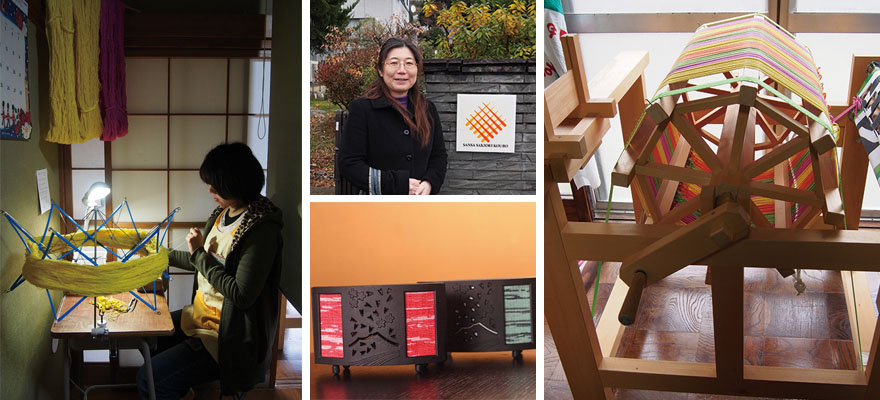Home > Highlighting JAPAN >Highlighting Japan January 2014>Leaning In - The Power of Womenomics -
Highlighting JAPAN
Leaning In - The Power of Womenomics -
Saccora Japan:
New Life from Old Cloth

Tucked away in a tranquil residential neighborhood on the outskirts of Morioka City, Iwate Prefecture, spindles whirr, looms click and clack, and the sound of shredding cotton fills the air of an unassuming two-story home. Here, in what was once a family living room, Saccora Japan's Sansa Sakiori Koubo gives old fabrics a vibrant new lease on life.
Sakiori ('saki' = shred, 'ori' = weaving) is the traditional art of rag weaving, where used textiles are shredded into thin strips and woven back into thick and durable material. According to Etsu Ishigashira, president of Saccora Japan, sakiori techniques flourished in northern Japan, where cotton was historically cherished as a rare commodity carried all the way from Kyoto. "The sakiori process embodies a respect for objects that is particular to Japan's culture of conservationism," she explains, referencing the 'mottainai' spirit, the Japanese ethic that strives to make full use of limited resources.
Named after Morioka's Sansa Odori Festival, Sansa Sakiori Koubo recycles the colorful yukata (traditional cotton robes) worn by the thousands of dancers and drummers who fill Morioka's Chūō-dōri Street each summer. The name of Saccora Japan even derives from 'Saccora choiwa yasse,' a chant heard at the Sansa Odori Festival. While 'choiwa yasse' is an excited exclamation with no precise meaning, in the local dialect, 'saccora' roughly means, 'Happiness will come to you when you call for it.'
Saccora Japan was formed as a result of Ishigashira's visit to a local special support education high school in 2009. She was so impressed with the sakiori woven by the school's students that she created her workshop – or koubo – to give them a place to apply their skills, as well as offer an opportunity to build experience they could use as a stepping stone to future employment. Now as many as ten employees with mental, physical and emotional disabilities contribute to the sakiori process.
Once the weaving is complete, the colorful material is sewn into artistic coasters, pencil cases, lamp frames and book covers. Ishigashira's female sensibilities shine out in the ingenuity of marrying a traditional, region-based craft with the vibrant pinks, bright yellows and gleaming greens of the Sansa Odori Festival. With their refined yet practical designs, these products have attracted attention even among the high-end retailers of Tokyo's Ginza shopping district.
As an entrepreneur who has found success in a creative business plan managed through a woman's perspective, Ishigashira received honorable mention in the start-up category at the 11th Women Entrepreneur Awards, hosted by the Chamber of Commerce and Industry Business Women's Club
in 2012.
Pointing to a self-designed, bright blue hunting cap, Ishigashira speaks of the need to preserve tradition through innovation, and now hopes that growing interest in Saccora's products will propel appreciation of this local craftsmanship beyond the borders of Japan.
© 2009 Cabinet Office, Government of Japan






